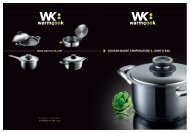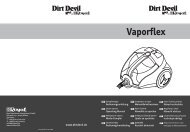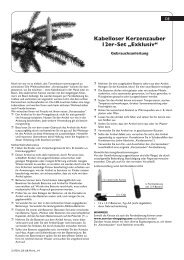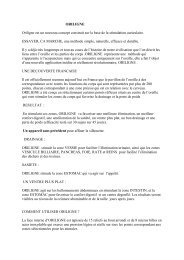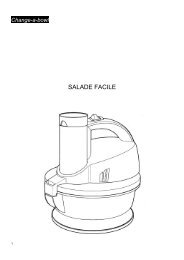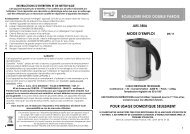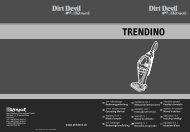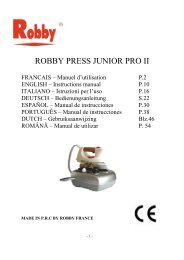Create successful ePaper yourself
Turn your PDF publications into a flip-book with our unique Google optimized e-Paper software.
OBJ_BUCH-1513-003.book Page 19 Monday, January 16, 2012 11:29 AM<br />
Maintenance and Service<br />
Before any work on the machine itself, pull the mains<br />
plug.<br />
Cleaning<br />
After painting, the system must be pumped empty and all<br />
paint-carrying parts must be cleaned.<br />
There are two possibilities for cleaning the system:<br />
– EasyClean: Using universal connectors, the system is connected<br />
to a water tap and flushed.<br />
– Alternative possibility: The system pumps fresh water<br />
from a bucket for cleaning.<br />
Proper cleaning is a prerequisite for perfect operation of the<br />
electric paint roller. No warranty claims can be undertaken if<br />
cleaning is not carried out or is carried out incorrectly.<br />
Keep the base unit, the holding clip 28 and the remote control<br />
8 clean. Clean them with a moist cloth. The base unit and the<br />
remote control may not be immersed into water.<br />
Always clean the paint roll, the paint applicator and the hose<br />
system with water.<br />
Preparation<br />
– Place down the paint applicator 3 on the edge of the paint<br />
bucket so that it rests on the bucket holder 14.<br />
– Loosen the double-SDS-connector 27 from the holding<br />
clip 28 and completely remove the intake hose 4 and the<br />
paint filter 22 from the paint bucket.<br />
– Remove the paint roll 16 from the paint applicator 3 (see<br />
“Changing the Paint Roll”, page 18).<br />
– Hold the paint applicator 3 above the paint bucket and<br />
press the trigger switch 7 until the hose system is pumped<br />
empty and no more paint comes out of the paint applicator.<br />
– Release the trigger switch 7 and switch the power tool off.<br />
– Pull the mains plug from the socket outlet.<br />
EasyClean (see figures G1–G4)<br />
Note: Use only the supplied hoses and adapters for connecting<br />
to the water supply.<br />
Preparing the water tap:<br />
– Unscrew the mixing nozzle from a water tap using the supplied<br />
mixing-nozzle spanner 30 or a suitable tool.<br />
– Screw the fitting adapter 31 (M22 or M24 thread) in or on<br />
the water tap.<br />
Additional water-tap adapters are available in the Bosch<br />
accessories program.<br />
Separating paint-carrying components:<br />
– Unlatch holding clamp 21.<br />
– Disengage pump lock 23.<br />
To relieve the lock tension, lightly push the pump lid 20 upward,<br />
if required.<br />
– Push the pump lid 20 downward to the stop and then carefully<br />
lift it out of the housing opening of base unit 5.<br />
– Loosen the SDS connection 32 at the bottom part of the intake<br />
hose 4.<br />
English | 19<br />
Flushing the system:<br />
– Carry the paint applicator 3, feed hose 2, pump lid 20 and<br />
intake hose 4 to the prepared water tap.<br />
Please note that paint may escape or leak from the system.<br />
– Attach the double-SDS-connector 27 to adapter 31 on the<br />
water tap.<br />
– Hold the paint applicator 3 over a suitable collecting container<br />
(e. g. a bucket).<br />
– Carefully open the water tap and run lukewarm water<br />
through the system.<br />
– When flushing, lightly press pump hose 33 together several<br />
times.<br />
This will lead to better cleaning results.<br />
Additionally, this also cleans bypass hose 34, which prevents<br />
the rotor from overloading in case of excessive pressure<br />
in the hose system.<br />
– Flush the system until only clear water comes out of the<br />
paint applicator.<br />
– Clean the paint filter 22 and the intake hose 4 (connect<br />
SDS connection 32 to the water tap and flush; additional<br />
cleaning of paint filter with brush).<br />
– Release the adapter 31 from the water tap and from the<br />
double-SDS-connector 27.<br />
Screw the mixing nozzle back onto water tap.<br />
Cleaning the paint applicator and the paint roll:<br />
– See “Cleaning the Paint Applicator and the Paint Roll”,<br />
page 20.<br />
Mounting together the dried components:<br />
– Allow all components to dry thoroughly.<br />
If possible, hang up the paint roll 16 to dry.<br />
If the paint roll is placed down to dry, the pile will be deformed.<br />
This may lead to an uneven surface quality when<br />
using the paint roller the next time.<br />
– Reconnect the intake hose 4 to the SDS connection 32 on<br />
the paint filter 22.<br />
– Manually turn rotor 35 to the indicated position (see figure<br />
G4) in order to avoid damage to pump hose 33 when inserting<br />
pump lid 20.<br />
– Reinsert the pump lid 20 into the housing opening and<br />
push it upward to the stop.<br />
– Shut pump lock 23 until it engages.<br />
– Lock holding clamp 21 again.<br />
Alternative Cleaning Method (see figure H)<br />
Note: This cleaning method takes somewhat longer than the<br />
EasyClean method.<br />
– Couple base unit 5 to the water bucket (also see “Coupling<br />
the Base Unit and the Paint Bucket”, page 17).<br />
– Insert paint filter 22 to the bottom of the water bucket.<br />
– Fasten the intake hose 4 in the holding clip 28.<br />
– Plug the mains plug into a socket outlet.<br />
– Make sure that the pump lock 23 is engaged.<br />
– To start the machine, push the On/Off switch 18 to the “I”<br />
position.<br />
– Hold paint applicator 3 over a suitable collecting container<br />
(e.g. a bucket) and actuate trigger switch 7 until only clear<br />
water comes out of the paint applicator and no more paint<br />
can be seen in the hoses (visual check).<br />
Bosch Power Tools 2 609 005 736 | (16.1.12)





